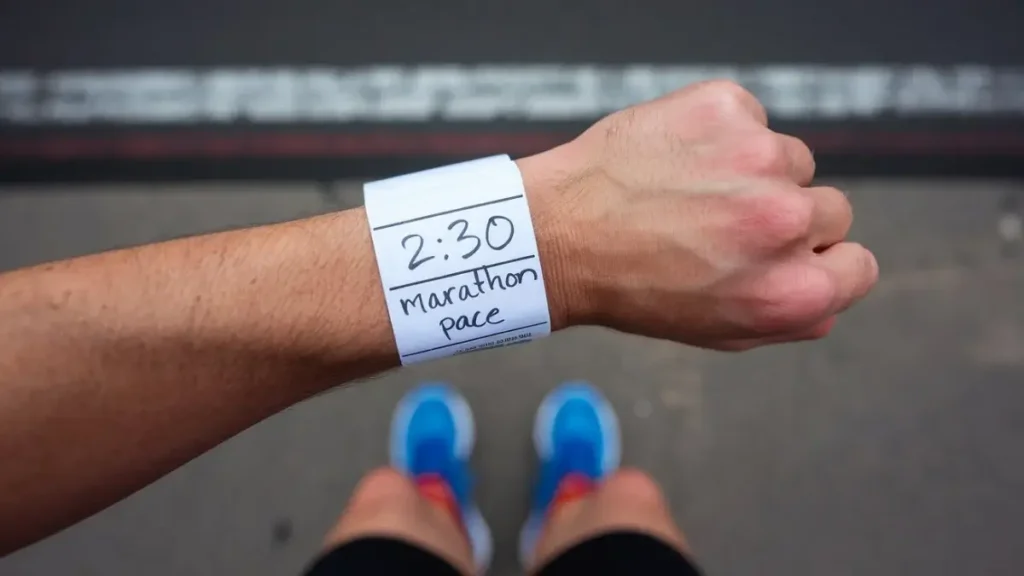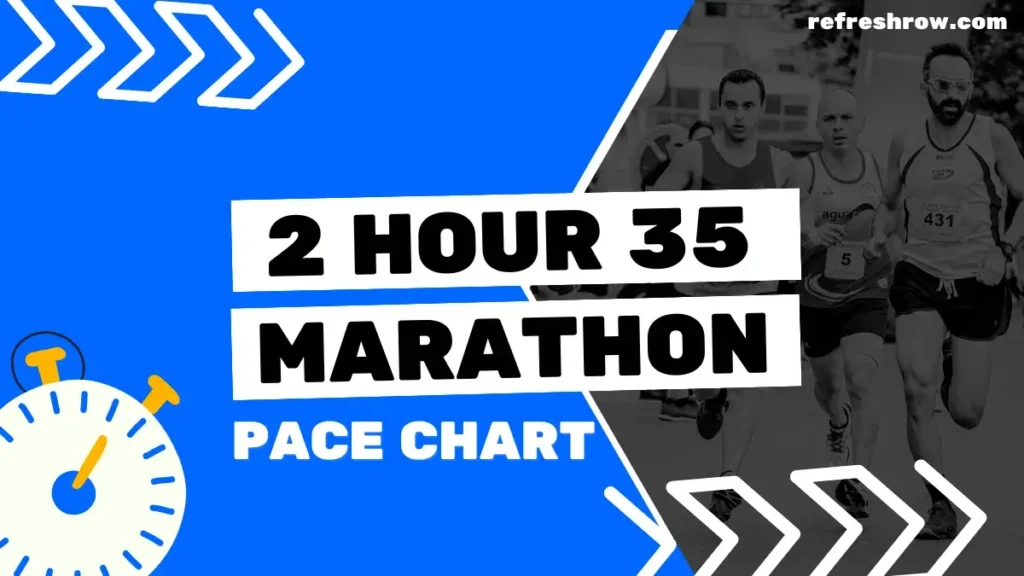To run a 4:35 hour marathon you need to run at a pace of 10:29 per mile or 6:31 per kilometer.
Following the splits below (and shaving off a second), you’ll run a sub 4:35 marathon.
I’d recommend aiming to run 1-2 minutes ahead of the split target time from 10 miles, as you’ll likely come up against crowding on race day.
4:35 Marathon Pace in Miles
| Mile | Split |
|---|---|
| 1 | 10:29 |
| 2 | 20:59 |
| 3 | 31:28 |
| 4 | 41:57 |
| 5 | 52:27 |
| 6 | 1:02:56 |
| 7 | 1:13:25 |
| 8 | 1:23:55 |
| 9 | 1:34:24 |
| 10 | 1:44:53 |
| 11 | 1:55:23 |
| 12 | 2:05:52 |
| 13 | 2:16:21 |
| 14 | 2:26:50 |
| 15 | 2:37:20 |
| 16 | 2:47:49 |
| 17 | 2:58:18 |
| 18 | 3:08:48 |
| 19 | 3:19:17 |
| 20 | 3:29:46 |
| 21 | 3:40:16 |
| 22 | 3:50:45 |
| 23 | 4:01:14 |
| 24 | 4:11:44 |
| 25 | 4:22:13 |
| 26 | 4:32:42 |
| 26.2 | 4:35:00 |
Download
4:35 Marathon Pace in KM
| KM | Split |
|---|---|
| 1 | 6:31 |
| 2 | 13:02 |
| 3 | 19:33 |
| 4 | 26:04 |
| 5 | 32:35 |
| 6 | 39:06 |
| 7 | 45:37 |
| 8 | 52:08 |
| 9 | 58:39 |
| 10 | 1:05:10 |
| 11 | 1:11:41 |
| 12 | 1:18:12 |
| 13 | 1:24:44 |
| 14 | 1:31:15 |
| 15 | 1:37:46 |
| 16 | 1:44:17 |
| 17 | 1:50:48 |
| 18 | 1:57:19 |
| 19 | 2:03:50 |
| 20 | 2:10:21 |
| 21 | 2:16:52 |
| 22 | 2:23:23 |
| 23 | 2:29:54 |
| 24 | 2:36:25 |
| 25 | 2:42:56 |
| 26 | 2:49:27 |
| 27 | 2:55:58 |
| 28 | 3:02:29 |
| 29 | 3:09:00 |
| 30 | 3:15:31 |
| 31 | 3:22:02 |
| 32 | 3:28:33 |
| 33 | 3:35:04 |
| 34 | 3:41:35 |
| 35 | 3:48:06 |
| 36 | 3:54:37 |
| 37 | 4:01:09 |
| 38 | 4:07:40 |
| 39 | 4:14:11 |
| 40 | 4:20:42 |
| 41 | 4:27:13 |
| 42 | 4:33:44 |
| 42.2 | 4:35:00 |
Download
Other Marathon Pace Charts
Targeting a different time?
Check out the Full Marathon Pace Chart in Miles or KM
Or select a specific finishing time below:
| 3:00 | 4:00 | 5:00 | |
| 3:05 | 4:05 | 5:15 | |
| 3:10 | 4:10 | 5:30 | |
| 3:15 | 4:15 | 5:45 | |
| 3:20 | 4:20 | 6:00 | |
| 3:25 | 4:25 | 6:15 | |
| 2:30 | 3:30 | 4:30 | 6:30 |
| 2:35 | 3:35 | 4:35 | 6:45 |
| 2:40 | 3:40 | 4:40 | 7:00 |
| 2:45 | 3:45 | 4:45 | |
| 2:50 | 3:50 | 4:50 | |
| 2:55 | 3:55 | 4:55 |
Training for a 4:35 Marathon
Is 4:35 a Good Marathon Time?
Well, what do the stats say?
Run Repeat conducted a study that contains 19,614,975 marathon results from more than 32,335 races across the globe, here is how a 4:35 marathon compares against age and gender for the races recorded:
| Overall | You’re faster than 42.8% of all runners. |
| Male | You’re faster than 32.4% of males. |
| Female | You’re faster than 56.7% of females. |
| <20 | You’re faster than 41.7% of under 20s. |
| 20-29 | You’re faster than 35.4% of 20-29 year olds. |
| 30-39 | You’re faster than 35.3% of 30-39 year olds. |
| 40-49 | You’re faster than 39.6% of 40-49 year olds. |
| 50-59 | You’re faster than 52.6% of 50-59 year olds. |
| >60 | You’re faster than 73.3% of over 60s. |
Training Runs and Paces for a 4:35 Marathon
To break a 4:35 marathon you’ll need to do some serious distance in your training, I recommend at least 15 miles (24km) per week.
You’re also going to need to make sure you’ve crossed off these milestones for other race distances:
- A 5k in 28:25 mins
- A 10k in 59:50 mins
- A half marathon in 2 hour 6 mins
Training Paces
| Pace | Mins per Mile | Mins per KM |
|---|---|---|
| Easy | 11:49 | 7:20 |
| Steady | 10:29 | 6:31 |
| 10k | 9:37 | 5:58 |
| 5k | 9:13 | 5:44 |
| 1 Mile | 8:34 | 5:21 |
Weekly Mileage Targets
| Target Mileage: | Gradually increase your weekly mileage from 20 miles (32 km) to a peak of 28 miles (45 km). |
| Incremental Increase: | Increase mileage by approximately 10% each week, with every fourth week as a recovery week where mileage is reduced by 20-30%. Make sure to taper for the last 1-2 weeks. |
Long Run Structure
| Total Distance: | Build up to long runs of 18-20 miles (29-32 km). |
| Segment Example: | First 5 miles (8 km): Easy pace, heart rate 140-150 bpm (approximately 12:45/mile or 7:55/km). Next 1 mile (1.6 km): Fast pace at 9:00/mile (5:35/km). Next 5 miles (8 km): Medium effort, heart rate around 160 bpm (approximately 10:00/mile or 6:13/km). Repeat: Repeat the segment twice (5 miles easy, 1 mile fast, 5 miles medium), you can taper the final 2 miles if required. |
Why This Works: Incorporating varied paces within long runs enhances lactate tolerance, which helps on race day when you’ve got to maintain pace despite feeling fatigued. By practicing surges during a run, you can build up your physical and mental resilience (lots of elite marathon runners use these strategies during their training)
Alternating Long Runs: Alternate between structured long runs (easy/fast segments) and easier long runs. For easier long runs, maintain a steady, comfortable pace throughout, focusing on mileage rather than speed to aid recovery.
Speedwork Sessions
| Short Intervals: | – 800m repeats at 4:30 per interval (5:37/km). – Aim for 5-7 repetitions with equal time for recovery. |
| Mile Repeats: | – 1 mile repeats at 9:00 per mile (5:35/km). – Aim for 4-6 repetitions with a 1-2 minute recovery jog. |
| Longer Intervals: | – 2 mile repeats at 9:10 per mile (5:41/km). – Aim for 3-4 repetitions with a 2-3 minute recovery jog. |
Recovery and Rest Days
| Rest Days: | You don’t need to incorporate rest days if you are using recovery runs, but I recommend taking 1 (or a max of 2) per week to allow your body to recover and prevent overtraining. |
| Easy Run Days: | Include 1-2 easy run days per week at a relaxed pace of 13:00/mile (8:04/km), covering 3-5 miles (5-8 km) per day. Try to keep your heart rate below 140 bpm on easy days to ensure proper recovery and aerobic development. |
My Tips to Run a Sub 4:35 Marathon
Set Realistic Training Goals
It’s important to set achievable weekly goals rather than focusing too much on speed.
One of the things that helped me as a beginner was planning my weekly runs around manageable distances, like aiming for 3-4 shorter runs during the week and one long run on the weekend.
You don’t need to run crazy distances every day to succeed – just make sure you’re gradually increasing your mileage week by week.
Small, consistent gains will help you get to that 4:35 goal without overwhelming yourself.
Prioritize Recovery Days
One mistake I made early on was ignoring my recovery days.
I was too eager to keep running and ended up feeling fatigued, sore, and inevitably injured myself which stopped me from running for months.
Make sure you schedule at least one full rest day and use easy recovery runs or walks to give your muscles time to heal.
Trust me, rest days are just as important as your runs – they are the glue that holds your training schedule together and make it sustainable.
Embrace Cross-Training to Prevent Injury
One of the best decisions I made during my training was to include cross-training in my routine.
Instead of running six days a week, I swapped one or two of those sessions with swimming or cycling.
This allowed me to build cardiovascular strength without putting too much strain on my legs, reducing my risk of injury.
Cross-training can be your secret weapon to staying healthy throughout your training cycle, especially if you’re a beginner trying to balance running with recovery.
Plus, it keeps things fresh and breaks the monotony of long-distance running.
Use Pace Bands or Apps for Pacing
Keeping a steady pace can be tough, especially if you’re new to longer distances.
One thing that really helps me during my marathons is using a pace band to track my time at each mile (you can download one above).
Having a visual guide keeps me from going too fast at the start and ensures that I stay on track without having to constantly check my watch.
You can also use a pacing app like Starva or a fitness watch, however…
Top Tip: if you’re running in a city with tall buildings, your GPS won’t work properly so the pace measurement will be inaccurate .
It’s best to just use the clock and your pace band, as you know it’ll be 100% correct.


Row Brown is the founder of Refresh Row. He is a keen marathon runner, his favorite being the London Marathon. He’s now set himself the mission of Running the Entire Length of Spain, which is scheduled for late 2024.


